英语s发音规则
- 格式:doc
- 大小:50.50 KB
- 文档页数:10
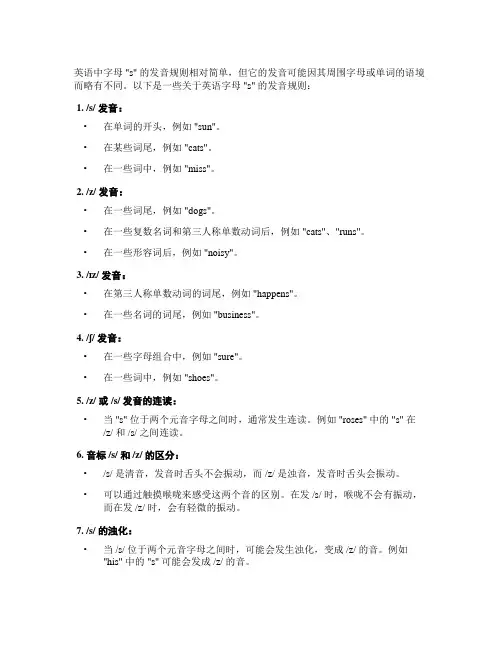
英语中字母 "s" 的发音规则相对简单,但它的发音可能因其周围字母或单词的语境而略有不同。
以下是一些关于英语字母 "s" 的发音规则:1. /s/ 发音:•在单词的开头,例如 "sun"。
•在某些词尾,例如 "cats"。
•在一些词中,例如 "miss"。
2. /z/ 发音:•在一些词尾,例如 "dogs"。
•在一些复数名词和第三人称单数动词后,例如 "cats"、"runs"。
•在一些形容词后,例如 "noisy"。
3. /ɪz/ 发音:•在第三人称单数动词的词尾,例如 "happens"。
•在一些名词的词尾,例如 "business"。
4. /ʃ/ 发音:•在一些字母组合中,例如 "sure"。
•在一些词中,例如 "shoes"。
5. /z/ 或 /s/ 发音的连读:•当 "s" 位于两个元音字母之间时,通常发生连读。
例如 "roses" 中的 "s" 在/z/ 和 /s/ 之间连读。
6. 音标 /s/ 和 /z/ 的区分:•/s/ 是清音,发音时舌头不会振动,而 /z/ 是浊音,发音时舌头会振动。
•可以通过触摸喉咙来感受这两个音的区别。
在发 /s/ 时,喉咙不会有振动,而在发 /z/ 时,会有轻微的振动。
7. /s/ 的浊化:•当 /s/ 位于两个元音字母之间时,可能会发生浊化,变成 /z/ 的音。
例如"his" 中的 "s" 可能会发成 /z/ 的音。
8. /s/ 的弱读发音:•在一些情况下,例如在某些代词或冠词之后,/s/ 可以被弱化,发音成 /z/ 或省略。
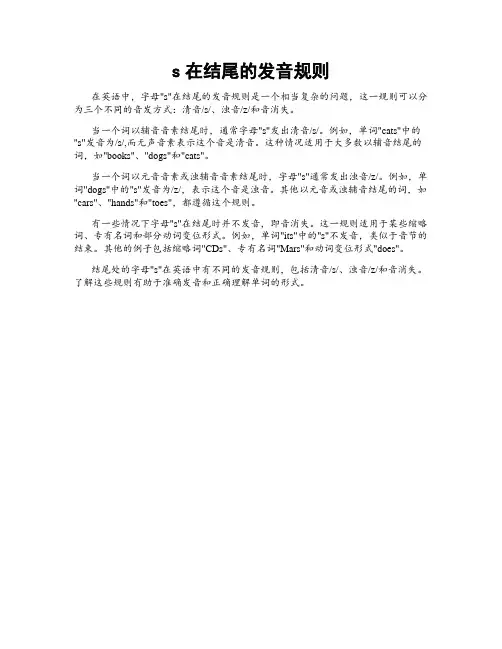
s在结尾的发音规则
在英语中,字母"s"在结尾的发音规则是一个相当复杂的问题,这一规则可以分为三个不同的音发方式:清音/s/、浊音/z/和音消失。
当一个词以辅音音素结尾时,通常字母"s"发出清音/s/。
例如,单词"cats"中的"s"发音为/s/,而无声音素表示这个音是清音。
这种情况适用于大多数以辅音结尾的词,如"books"、"dogs"和"cats"。
当一个词以元音音素或浊辅音音素结尾时,字母"s"通常发出浊音/z/。
例如,单词"dogs"中的"s"发音为/z/,表示这个音是浊音。
其他以元音或浊辅音结尾的词,如"cars"、"hands"和"toes",都遵循这个规则。
有一些情况下字母"s"在结尾时并不发音,即音消失。
这一规则适用于某些缩略词、专有名词和部分动词变位形式。
例如,单词"its"中的"s"不发音,类似于音节的结束。
其他的例子包括缩略词"CDs"、专有名词"Mars"和动词变位形式"does"。
结尾处的字母"s"在英语中有不同的发音规则,包括清音/s/、浊音/z/和音消失。
了解这些规则有助于准确发音和正确理解单词的形式。
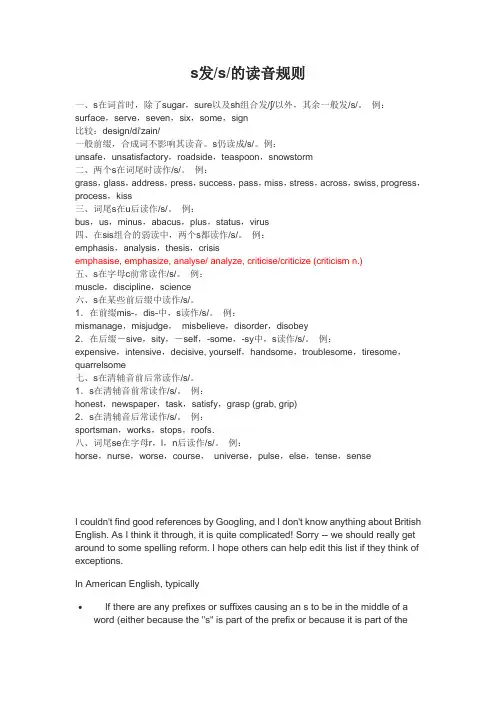
s发/s/的读音规则一、s在词首时,除了sugar,sure以及sh组合发/ʃ/以外,其余一般发/s/。
例:surface,serve,seven,six,some,sign比较:design/di'zain/一般前缀,合成词不影响其读音。
s仍读成/s/。
例:unsafe,unsatisfactory,roadside,teaspoon,snowstorm二、两个s在词尾时读作/s/。
例:grass,glass,address,press,success,pass,miss,stress,across,swiss, progress,process,kiss三、词尾s在u后读作/s/。
例:bus,us,minus,abacus,plus,status,virus四、在sis组合的弱读中,两个s都读作/s/。
例:emphasis,analysis,thesis,crisisemphasise, emphasize, analyse/ analyze, criticise/criticize (criticism n.)五、s在字母c前常读作/s/。
例:muscle,discipline,science六、s在某些前后缀中读作/s/。
1.在前缀mis-,dis-中,s读作/s/。
例:mismanage,misjudge,misbelieve,disorder,disobey2.在后缀-sive,sity,-self,-some,-sy中,s读作/s/。
例:expensive,intensive,decisive, yourself,handsome,troublesome,tiresome,quarrelsome七、s在清辅音前后常读作/s/。
1.s在清辅音前常读作/s/。
例:honest,newspaper,task,satisfy,grasp (grab, grip)2.s在清辅音后常读作/s/。
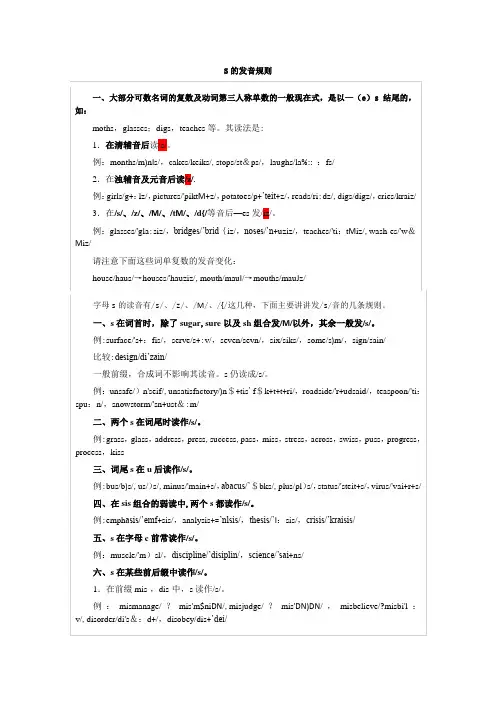
S的发音规则一、大部分可数名词的复数及动词第三人称单数的一般现在式,是以—(e)s结尾的,如:moths,glasses;digs,teaches等。
其读法是:1.在清辅音后读/s/。
例:months/m)n I s/,cakes/keiks/,stops/st&ps/,laughs/la%:: :fs/2.在浊辅音及元音后读/z/.例:girls/g+:lz/,pictures/'pikt M+z/,potatoes/p+’teit+z/,reads/ri:dz/,digs/digz/,cries/kraiz/ 3.在/s/、/z/、/M/、/t M/、/d{/等音后—es发/iz/。
例:glasses/'gla:siz/,bridges/’brid{iz/,noses/’n+uziz/,teaches/'ti:t M iz/,wash-es/'w&M iz/请注意下面这些词单复数的发音变化:house/haus/→houses/'hauziz/,mouth/mau I/→mouths/mau J z/字母s的读音有/s/、/z/、/M/、/{/这几种,下面主要讲讲发/s/音的几条规则。
一、s在词首时,除了sugar,sure以及sh组合发/M/以外,其余一般发/s/。
例:surface/'s+:fis/,serve/s+:v/,seven/sevn/,six/siks/,some/s)m/,sign/sain/比较:design/di’zain/一般前缀,合成词不影响其读音。
s仍读成/s/。
例:unsafe/)n'seif/,unsatisfactory/)n$+tis'f$k+t+t+ri/,roadside/'r+udsaid/,teaspoon/'ti:spu:n/,snowstorm/'sn+ust&:m/二、两个s在词尾时读作/s/。
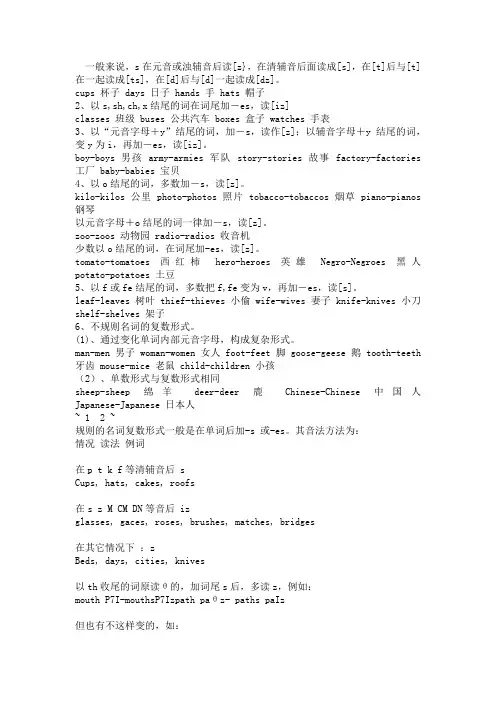
一般来说,s在元音或浊辅音后读[z},在清辅音后面读成[s],在[t]后与[t]在一起读成[ts],在[d]后与[d]一起读成[dz]。
cups 杯子 days 日子 hands 手 hats 帽子2、以s,sh,ch,x结尾的词在词尾加-es,读[iz]classes 班级 buses 公共汽车 boxes 盒子 watches 手表3、以“元音字母+y”结尾的词,加-s,读作[z];以辅音字母+y结尾的词,变y为i,再加-es,读[iz]。
boy-boys 男孩 army-armies 军队 story-stories 故事 factory-factories 工厂 baby-babies 宝贝4、以o结尾的词,多数加-s,读[z]。
kilo-kilos 公里 photo-photos 照片 tobacco-tobaccos 烟草 piano-pianos 钢琴以元音字母+o结尾的词一律加-s,读[z]。
zoo-zoos 动物园 radio-radios 收音机少数以o结尾的词,在词尾加-es,读[z]。
tomato-tomatoes 西红柿hero-heroes 英雄Negro-Negroes 黑人potato-potatoes 土豆5、以f或fe结尾的词,多数把f,fe变为v,再加-es,读[s]。
leaf-leaves 树叶 thief-thieves 小偷 wife-wives 妻子 knife-knives 小刀shelf-shelves 架子6、不规则名词的复数形式。
(1)、通过变化单词内部元音字母,构成复杂形式。
man-men 男子 woman-women 女人 foot-feet 脚 goose-geese 鹅 tooth-teeth 牙齿 mouse-mice 老鼠 child-children 小孩(2)、单数形式与复数形式相同sheep-sheep 绵羊deer-deer 鹿Chinese-Chinese 中国人Japanese-Japanese 日本人~ 1 2 ~规则的名词复数形式一般是在单词后加-s 或-es。
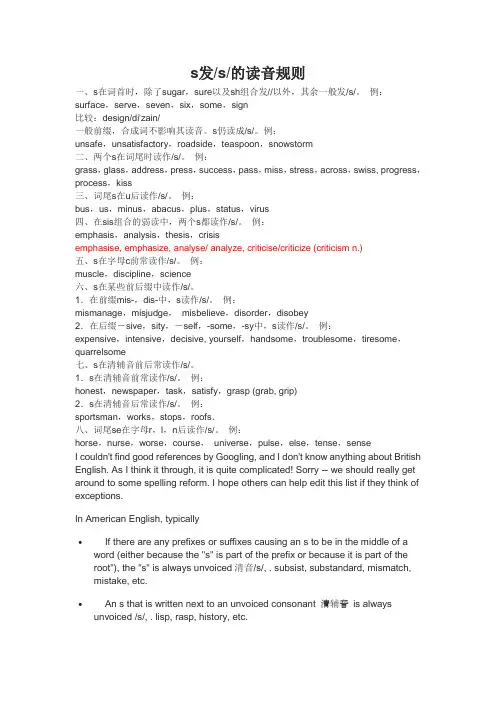
s发/s/的读音规则一、s在词首时,除了sugar,sure以及sh组合发//以外,其余一般发/s/。
例:surface,serve,seven,six,some,sign比较:design/di'zain/一般前缀,合成词不影响其读音。
s仍读成/s/。
例:unsafe,unsatisfactory,roadside,teaspoon,snowstorm二、两个s在词尾时读作/s/。
例:grass,glass,address,press,success,pass,miss,stress,across,swiss, progress,process,kiss三、词尾s在u后读作/s/。
例:bus,us,minus,abacus,plus,status,virus四、在sis组合的弱读中,两个s都读作/s/。
例:emphasis,analysis,thesis,crisisemphasise, emphasize, analyse/ analyze, criticise/criticize (criticism n.)五、s在字母c前常读作/s/。
例:muscle,discipline,science六、s在某些前后缀中读作/s/。
1.在前缀mis-,dis-中,s读作/s/。
例:mismanage,misjudge,misbelieve,disorder,disobey2.在后缀-sive,sity,-self,-some,-sy中,s读作/s/。
例:expensive,intensive,decisive, yourself,handsome,troublesome,tiresome,quarrelsome七、s在清辅音前后常读作/s/。
1.s在清辅音前常读作/s/。
例:honest,newspaper,task,satisfy,grasp (grab, grip)2.s在清辅音后常读作/s/。
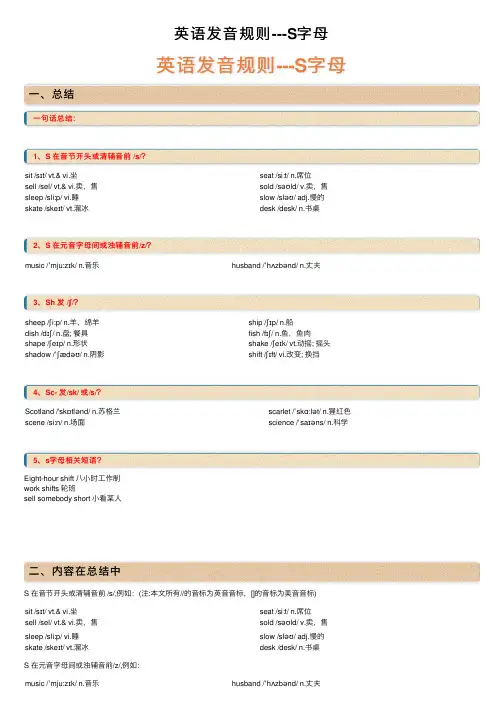
英语发⾳规则---S字母英语发⾳规则---S字母⼀、总结⼀句话总结:1、S 在⾳节开头或清辅⾳前 /s/?sit /sɪt/ vt.& vi.坐seat /si:t/ n.席位sell /sel/ vt.& vi.卖,售sold /səʊld/ v.卖,售sleep /sli:p/ vi.睡slow /sləʊ/ adj.慢的skate /skeɪt/ vt.溜冰desk /desk/ n.书桌2、S 在元⾳字母间或浊辅⾳前/z/?music /ˈmju:zɪk/ n.⾳乐husband /ˈhʌzbənd/ n.丈夫3、Sh 发 /ʃ/?sheep /ʃi:p/ n.⽺,绵⽺ship /ʃɪp/ n.船dish /dɪʃ/ n.盘; 餐具fish /fɪʃ/ n.鱼,鱼⾁shape /ʃeɪp/ n.形状shake /ʃeɪk/ vt.动摇; 摇头shadow /ˈʃædəʊ/ n.阴影shift /ʃɪft/ vi.改变; 换挡4、Sc- 发/sk/ 或/s/?Scotland /'skɒtlənd/ n.苏格兰scarlet /ˈskɑ:lət/ n.猩红⾊scene /si:n/ n.场⾯science /ˈsaɪəns/ n.科学5、s字母相关短语?Eight-hour shift ⼋⼩时⼯作制work shifts 轮班sell somebody short ⼩看某⼈⼆、内容在总结中S 在⾳节开头或清辅⾳前 /s/,例如:(注:本⽂所有//的⾳标为英⾳⾳标,[]的⾳标为美⾳⾳标)sit /sɪt/ vt.& vi.坐seat /si:t/ n.席位sell /sel/ vt.& vi.卖,售sold /səʊld/ v.卖,售sleep /sli:p/ vi.睡slow /sləʊ/ adj.慢的skate /skeɪt/ vt.溜冰desk /desk/ n.书桌S 在元⾳字母间或浊辅⾳前/z/,例如:music /ˈmju:zɪk/ n.⾳乐husband /ˈhʌzbənd/ n.丈夫Sh 发 /ʃ/,例如:sheep /ʃi:p/ n.⽺,绵⽺ship /ʃɪp/ n.船dish /dɪʃ/ n.盘; 餐具fish /fɪʃ/ n.鱼,鱼⾁shape /ʃeɪp/ n.形状shake /ʃeɪk/ vt.动摇; 摇头shadow /ˈʃædəʊ/ n.阴影shift /ʃɪft/ vi.改变; 换挡Sc- 发/sk/ 或/s/,例如:Scotland /'skɒtlənd/ n.苏格兰scarlet /ˈskɑ:lət/ n.猩红⾊scene /si:n/ n.场⾯science /ˈsaɪəns/ n.科学Eight-hour shift ⼋⼩时⼯作制work shifts 轮班sell somebody short ⼩看某⼈。
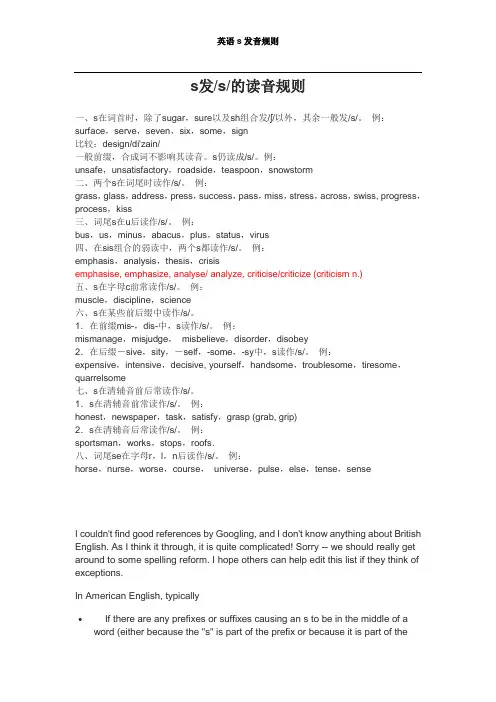
s发/s/的读音规则一、s在词首时,除了sugar,sure以及sh组合发/ʃ/以外,其余一般发/s/。
例:surface,serve,seven,six,some,sign比较:design/di'zain/一般前缀,合成词不影响其读音。
s仍读成/s/。
例:unsafe,unsatisfactory,roadside,teaspoon,snowstorm二、两个s在词尾时读作/s/。
例:grass,glass,address,press,success,pass,miss,stress,across,swiss, progress,process,kiss三、词尾s在u后读作/s/。
例:bus,us,minus,abacus,plus,status,virus四、在sis组合的弱读中,两个s都读作/s/。
例:emphasis,analysis,thesis,crisisemphasise, emphasize, analyse/ analyze, criticise/criticize (criticism n.)五、s在字母c前常读作/s/。
例:muscle,discipline,science六、s在某些前后缀中读作/s/。
1.在前缀mis-,dis-中,s读作/s/。
例:mismanage,misjudge,misbelieve,disorder,disobey2.在后缀-sive,sity,-self,-some,-sy中,s读作/s/。
例:expensive,intensive,decisive, yourself,handsome,troublesome,tiresome,quarrelsome七、s在清辅音前后常读作/s/。
1.s在清辅音前常读作/s/。
例:honest,newspaper,task,satisfy,grasp (grab, grip)2.s在清辅音后常读作/s/。
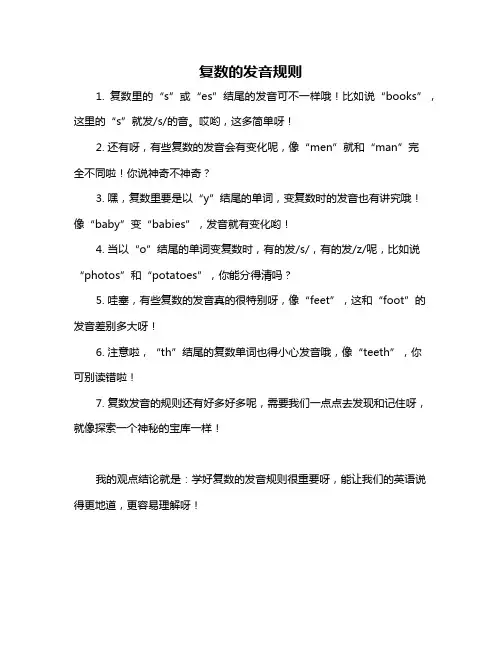
复数的发音规则
1. 复数里的“s”或“es”结尾的发音可不一样哦!比如说“books”,这里的“s”就发/s/的音。
哎哟,这多简单呀!
2. 还有呀,有些复数的发音会有变化呢,像“men”就和“man”完
全不同啦!你说神奇不神奇?
3. 嘿,复数里要是以“y”结尾的单词,变复数时的发音也有讲究哦!
像“baby”变“babies”,发音就有变化哟!
4. 当以“o”结尾的单词变复数时,有的发/s/,有的发/z/呢,比如说“photos”和“potatoes”,你能分得清吗?
5. 哇塞,有些复数的发音真的很特别呀,像“feet”,这和“foot”的发音差别多大呀!
6. 注意啦,“th”结尾的复数单词也得小心发音哦,像“teeth”,你
可别读错啦!
7. 复数发音的规则还有好多好多呢,需要我们一点点去发现和记住呀,就像探索一个神秘的宝库一样!
我的观点结论就是:学好复数的发音规则很重要呀,能让我们的英语说得更地道,更容易理解呀!。
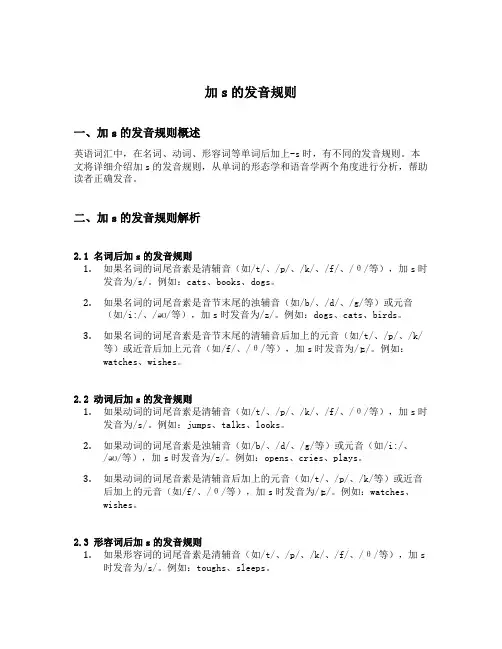
加s的发音规则一、加s的发音规则概述英语词汇中,在名词、动词、形容词等单词后加上-s时,有不同的发音规则。
本文将详细介绍加s的发音规则,从单词的形态学和语音学两个角度进行分析,帮助读者正确发音。
二、加s的发音规则解析2.1 名词后加s的发音规则1.如果名词的词尾音素是清辅音(如/t/、/p/、/k/、/f/、/θ/等),加s时发音为/s/。
例如:cats、books、dogs。
2.如果名词的词尾音素是音节末尾的浊辅音(如/b/、/d/、/g/等)或元音(如/i:/、/əʊ/等),加s时发音为/z/。
例如:dogs、cats、birds。
3.如果名词的词尾音素是音节末尾的清辅音后加上的元音(如/t/、/p/、/k/等)或近音后加上元音(如/f/、/θ/等),加s时发音为/ɪz/。
例如:watches、wishes。
2.2 动词后加s的发音规则1.如果动词的词尾音素是清辅音(如/t/、/p/、/k/、/f/、/θ/等),加s时发音为/s/。
例如:jumps、talks、looks。
2.如果动词的词尾音素是浊辅音(如/b/、/d/、/g/等)或元音(如/i:/、/əʊ/等),加s时发音为/z/。
例如:opens、cries、plays。
3.如果动词的词尾音素是清辅音后加上的元音(如/t/、/p/、/k/等)或近音后加上的元音(如/f/、/θ/等),加s时发音为/ɪz/。
例如:watches、wishes。
2.3 形容词后加s的发音规则1.如果形容词的词尾音素是清辅音(如/t/、/p/、/k/、/f/、/θ/等),加s时发音为/s/。
例如:toughs、sleeps。
2.如果形容词的词尾音素是浊辅音(如/b/、/d/、/g/等)或元音(如/i:/、/əʊ/等),加s时发音为/z/。
例如:happys、crazys。
3.如果形容词的词尾音素是清辅音后加上的元音(如/t/、/p/、/k/等)或近音后加上的元音(如/f/、/θ/等),加s时发音为/ɪs/。
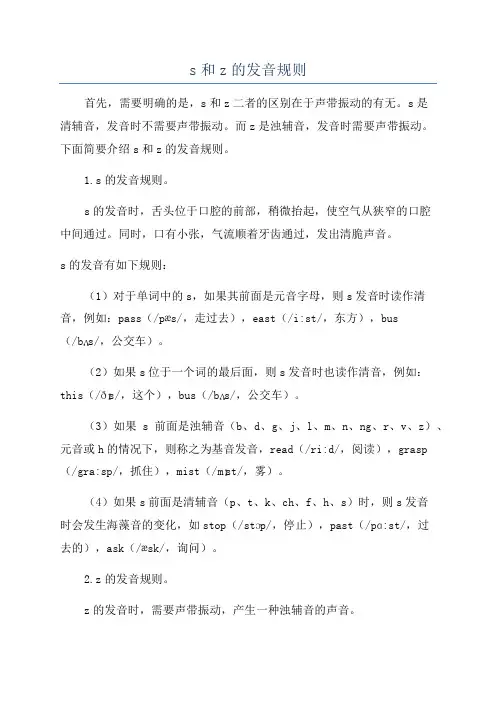
s和z的发音规则首先,需要明确的是,s和z二者的区别在于声带振动的有无。
s是清辅音,发音时不需要声带振动。
而z是浊辅音,发音时需要声带振动。
下面简要介绍s和z的发音规则。
1.s的发音规则。
s的发音时,舌头位于口腔的前部,稍微抬起,使空气从狭窄的口腔中间通过。
同时,口有小张,气流顺着牙齿通过,发出清脆声音。
s的发音有如下规则:(1)对于单词中的s,如果其前面是元音字母,则s发音时读作清音,例如:pass(/pæs/,走过去),east(/i:st/,东方),bus(/bʌs/,公交车)。
(2)如果s位于一个词的最后面,则s发音时也读作清音,例如:this(/ðɪs/,这个),bus(/bʌs/,公交车)。
(3)如果s前面是浊辅音(b、d、g、j、l、m、n、ng、r、v、z)、元音或h的情况下,则称之为基音发音,read(/ri:d/,阅读),grasp (/gra:sp/,抓住),mist(/mɪst/,雾)。
(4)如果s前面是清辅音(p、t、k、ch、f、h、s)时,则s发音时会发生海藻音的变化,如stop(/stɔp/,停止),past(/pɑ:st/,过去的),ask(/æsk/,询问)。
2.z的发音规则。
z的发音时,需要声带振动,产生一种浊辅音的声音。
z的发音有如下规则:(1)对于单词中的z,如果其前面是元音字母,则z发音时读作浊音,例如:zoo(/zu:/,动物园),lazy(/lei:zi/,懒人)。
(2)如果z位于一个词的最后面,则z发音时读作浊音,例如:fez (/fez/,菲斯帽子),does(/dʌz/,第三人称单数动词做)。
(3)如果z前面是基音(b、d、g、j、l、m、n、ng、r、v、z)、元音或h的情况下,则称之为基音发音,如rose(/rəʊz/,玫瑰),blah (/blɑː/,无聊)。
(4)如果z前面是s、sh、ch或j四个辅音中的任意一个,z在发音时会发生类似于语音学术语中的同化过程,即清辅音前后的音位特征相互传递,形成新的浊辅音。
英语s发音规则s发/s/的读音规则一、s在词首时,除了sugar,sure以及sh组合发/ʃ/以外,其余一般发/s/。
例:surface,serve,seven,six,some,sign比较:design/di'zain/一般前缀,合成词不影响其读音。
s仍读成/s/。
例:unsafe,unsatisfactory,roadside,teaspoon,snowstorm二、两个s在词尾时读作/s/。
例:grass,glass,address,press,success,pass,miss,stress,across,swiss, progress,process,kiss三、词尾s在u后读作/s/。
例:bus,us,minus,abacus,plus,status,virus四、在sis组合的弱读中,两个s都读作/s/。
例:emphasis,analysis,thesis,crisisemphasise, emphasize, analyse/ analyze, criticise/criticize (criticism n.)五、s在字母c前常读作/s/。
例:muscle,discipline,science六、s在某些前后缀中读作/s/。
1.在前缀mis-,dis-中,s读作/s/。
例:mismanage,misjudge,misbelieve,disorder,disobey2.在后缀-sive,sity,-self,-some,-sy中,s读作/s/。
例:expensive,intensive,decisive, yourself,handsome,troublesome,tiresome,quarrelsome七、s在清辅音前后常读作/s/。
1.s在清辅音前常读作/s/。
例:honest,newspaper,task,satisfy,grasp (grab, grip)2.s在清辅音后常读作/s/。
例:sportsman,works,stops,roofs.八、词尾se在字母r,l,n后读作/s/。
例:horse,nurse,worse,course,universe,pulse,else,tense,senseI couldn't find good references by Googling, and I don't know anything about British English. As I think it through, it is quite complicated! Sorry -- we should really get around to some spelling reform. I hope others can help edit this list if they think of exceptions.In American English, typically•If there are any prefixes or suffixes causing an s to be in the middle ofa word (either because the "s" is part of the prefix or because it is part ofthe root"), the "s" is always unvoiced清音/s/, e.g. subsist, substandard, mismatch, mistake, etc.•An s that is written next to an unvoiced consonant 清辅音is always unvoiced /s/, e.g. lisp, rasp, history, etc.•When the unvoiced consonant of the above rule is [t], then the /t/ is silent if the next syllable is syllabic /n/ or /l/: listen, whistle. (Otherwise it is pronounced. See the comments for a more detailed description of this rule.)•An s before m is always voiced /z/: chasm, prism, plasma. However, the top rule takes precedence有优先权, so the s in mismatch is always voiceless /s/.•An s that is written doubled between vowels is also unvoiced: massive, missive, missile, etc. However, if the s would occur in thephonetic stream /s+j/ then it assimilates to /ʃ/, e.g. in mission.•An s that is written as one single letter between vowels is usually /z/,e.g. laser, risible, criticise/ criticize, desert, design, reason, busy, result,reserve, closer (the comparative form of the adjective "close", has an /s/ sound). In the same environment as mentioned above /z+j/ willassimilate to /ʒ/ e.g. in vision.•Terrible exception to the above: in dessert, the s is voiced to /z/. Many native English speakers misspell dessert for this reason. Note also that the difference between desert and dessert is not voicing, but whichsyllable gets the accent (it is the first in desert and the second indessert).•Possess and its derivatives are another exception; the middle "ss" is voiced to /z/. The terminating "ss" is not.•Other miscellaneous exceptions: The -ss- in the American state name Missouri is also exceptionally pronounced /z/. In raspberry, the p issilent and the [s] assimilates to the /b/, so is voiced to /z/.补充:Based on the immediately surrounding letters:•Word-internal -ns-, e.g. in insist, tense, tinsel, is almost alwayspronounced /ns/ with unvoiced /s/. This doesn't apply to words that end in -ns, like pens or lens(these have /nz/). Exceptions: cleanse and pansy, which have /nz/. For some speakers, certain (but not necessarily all)words starting with "trans" such as transit and transition have /nz/. •Word-internal -ls-, e.g. in else, pulse, is almost always pronounced /ls/with unvoiced /s/. This doesn't apply to words that end in -ls, like eels or steals (these have /lz/). Exception: palsy, which has /lz/.•Word-internal -rs-, e.g. in persist, verse, is almost always pronounced /rs/* with unvoiced /s/. This doesn't apply to words that end in -rs, like stars or yours (these have /rz/*).Based on identifying particular suffixes:•The ending -sive is usually pronounced /sɪv/ with voiceless /s/, even when there is a vowel letter immediately preceding the letter "s". For example, explosive, invasive, abusive, derisive are all pronounced with /s/.•The ending -osity is always pronounced with voiceless /s/.名词复数后面s的发音规则一般来说,s在元音或浊辅音后读[z},在清辅音后面读成[s],在[t]后与[t]在一起读成[ts],在[d]后与[d]一起读成[dz]。
cups 杯子days 日子hands 手hats 帽子2、以s,sh,ch,x结尾的词在词尾加-es,读[iz]classes 班级buses 公共汽车boxes 盒子watches 手表3、以“元音字母+y”结尾的词,加-s,读作[z];以辅音字母+y结尾的词,变y为i,再加-es,读[iz]。